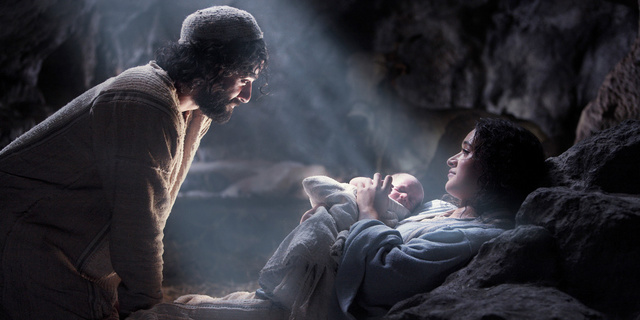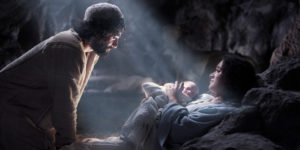Christmas: The Gritty Reboot
Every time I settle on one view of the first Christmas, some wise man comes along and tries to slather more grunge and grime on the manger.
You may know what I mean. When I was younger, the stable was a simple A-frame outdoor structure. The one on my family’s mantel had a little hook on the roof to hang an angel figurine. Inside were Joseph, leaning on his staff; Mary kneeling with her hands held spiritually high, palms out; and newborn six-month-old Jesus lying in a manger. Nearby were the shepherds, and of course Magi arrived earlier than scheduled.
I’m not sure when someone declared that stable out of date. But ever since, most Nativity re-enactments have bought new stable real estate, such as those Christian animated video episodes I loved, featuring time-traveling youths experiencing the first Christmas:
- “Superbook,” the first series that briefly covered the New Testament, showed Mary and Joseph arriving at a cave stable atop a hill (we never saw the inn).
 “The Greatest Adventure,” from Hanna-Barbera, also showed a cave stable.
“The Greatest Adventure,” from Hanna-Barbera, also showed a cave stable.- “The Flying House,” a series of animated New-Testament episodes, had a stable, sort of, in a fairly normal-looking downtown house, right on a Bethlehem avenue.
- In the “Adventures in Odyssey” radio series’s delightful Christmas three-part episode “Back to Bethlehem,” Connie Kendall is found liking the idea of Nativity romanticism (in the former sense of the word). That leads Mr. Whittaker to send her and the brainy collegian Eugene Meltsner to the first Christmas, via Whit’s time-travel/virtual-reality Imagination Station. In Bethlehem, Eugene debunks the stable-as-a-wood-frame-barn notion, saying instead, “the stable could have been inside a specially constructed cave.”(Oddly enough, Eugene views the presence of an innkeeper as one indication that that they’ve found the right inn, despite the fact that no innkeeper appears in Scripture!
- In The Nativity Story (2006), Joseph and an in-labor Mary take shelter in a cave-stable.
So there is it, brothers and sisters: out with the A-frame. Nativity Stable 2.0 is all cave. Let’s not buy into those Christmas myths, shall we? No warm glow from lamps in a cozy outdoor stable for you, Christ-child. That cave was not too great.
But wait! Here comes another clarification, thanks to one of my favorite Answers in Genesis contributors. In 2010, Tim Chaffey implicitly challenges any stable associated with an inn:
Joseph and Mary probably stayed with Joseph’s relatives in Bethlehem, but because of the large influx of people, the house would have been crowded and the kataluma (guest room) was full. Consequently, Joseph and Mary would have been relegated to living in the lower level of the house. It is hard to believe that pregnant Mary would have been turned away from a relative’s home in a society that greatly valued familial ties.
[…] This is where the manger comes into play. Mary likely gave birth to Jesus in the lower level of a crowded house, in which some of the animals had been brought in for the night. She then wrapped Jesus in swaddling cloths and laid Him in the manger (feeding trough). [Endnotes redacted.]
So here’s the transition thus far:
- A-frame stable, cozy if not smelly. Optional: provided by sympathetic innkeeper.
- Cave stable, grittier, smellier. Optional: Joseph and Mary are Homeless Outcasts.
- Bottom room of a family residence. No inn, no innkeeper. Difficulty level: average.
At this rate, by the year 2021 we may have the Holy Family sleeping in Bethlehem’s sewers. Ha ha, holiday-romantic evangelical, the first Christmas was Much Darker Than You Think.
So why do people keep gritty-rebooting the Christmas account in the first place?
One reason may be modern retconning. For instance, the alt-narrative of an innkeeper who would like to find a place for a pregnant woman but simply can’t because of all his inn’s full rooms, is exchanged for a stereotypical swindler. Activists thus hijack the Holy Family as just another example of their socio-political cause du jour: the Homeless, and/or the Poor.
Such special-bonus Moral Lessons may be just as distracting as over-romanticizing the Nativity. Later, AiG’s Tim Chaffey ultimately agrees about what is truly important:
We should never become so focused on the peripheral details of this account that we miss the most important point. Jesus Christ, the eternal Son of God, became a descendant of Adam so that He could ultimately go to the Cross and die in our place.
Amen, brother.
Still, I must wonder: could we not use a little Nativity “romance”? I dislike overemphasis on Thomas Kinkade-like bathe-all-the-scenes-in-holy-nostalgic-glows art as much as all the cool Christians. But why not add some wondrous angelic choirs? Perhaps a little less grit? A different stable setup? Or maybe even — gasp — the Christmas star’s white light beaming into the stable, bringing the early arrival of Magi, and magic?












































I think the “gritty-fixation” of adding the cave comes from research into what stables would have been like there (and then). A lot of our traditions are based on interpretations of the Bible that lacked archeological evidence, but as archeological evidence becomes more accessible to lay people, the traditions are coming more in line with that.
At least, that’s why I made it a cave when I wrote about it. 🙂
Yup, that’s the story I’m sticking with . . .
I also like the cave; at least we know the stable could have been a cave. The Spirit, inspiring Scripture, clearly didn’t thing the exact setting mattered.
My main concern is that in trying to get all the technical details right, we may miss the wonder, even “magic” of the central idea: God the Son became Man, and dwelled with people as a man to save them. Yes, it was “gritty.” Yet it was also wondrous.
All we really have to go off is this: To be enrolled with Mary, his espoused (married) wife, who was about to become a mother. 6And while they were there, the time came for her delivery, 7And she gave birth to her Son, her Firstborn; and she wrapped Him in swaddling clothes and laid Him in a manger, because there was no room or place for them in the inn.
And later on the angels tell the shepherds that Jesus was in a manger. Inn, cave, whatever, it would have been a lousy spot to have to have a baby. Having had three kids, you have no idea how much you want a bed, and a clean, warm place for your new baby. To have him in the place where the animals were–gosh, it’s amazing Mary didn’t die of childbed fever! Maybe baby Jesus healed her, who knows?
Gritty version of the Nativity? It WAS gritty because that’s how poverty is. The fact that the Creator of the Universe allowed himself to be born there shows how much he loves us, all creatures great and small.
Also, props for mentioning the Odyssey episodes. 🙂
I whole-heartedly agree we need to stick with Scripture here, and support that with the best we know about that culture. Definitely we must not over-romanticize and evaluate all traditions based on those.
At the same time, let’s not throw out all the magic of this story surrounding the truth: that God came to dwell with us — as Kessie mentioned, an incredible love and truth.
All I have to say about this is “Yes.” To everything that’s been said. (Sorry to be so disagreeable…)
In order to depict/visualize the scene with any historical accuracy, we need more information than what’s provided in the gospel accounts. The data supplied by archaeology, while interesting, is often speculative and incomplete. [Should that be “data… are incomplete”?]
Anyway, when God doesn’t give us specifics, it might be safe to infer that those details don’t matter. I think we can be free to illustrate the story with whatever props we and our readers can most relate to. Relating to the story personally is what it’s all about, after all.
Agreed, so long as the main thrust of the True Story is not compromised.
I had similar issues with The Passion of the Christ, though for a different reason. For the nativity account, it matters to capture the wonder, or as I dare to call it “magic,” of the central truth that God Himself, God the Son, was actually born as an incarnated human child. By contrast, for the crucifixion account, it matters to show that Christ’s sufferings were not merely gritty and physical, but profoundly spiritual. That is why no one can “outdo” His sufferings — He suffered not a worst physical torture, but the very forsaking of God the Father, temporarily, and full outpouring of His wrath. While The Passion of the Christ had many strengths, it was limited in how it could portray this spiritual reality in a visual-only medium.
I don’t see this trend you speak of. Family Christian Store is still full of cute, even kitschy, Nativity sets, from traditional models to Peanuts-themed packs. I’d agree more with Ben–it seems to steam more from a desire for accuracy than grittiness.
True, the trend isn’t everywhere. We must still deal with evangelical kitsch.
Yet among Spec-Faith’s audience, the impulse may be to fight kitsch more than chase Christmas wonder. Often that’s my impulse, anyway — an anti. 🙂
My question, then, is this: will getting the Details right lead to more wonder that God became Man to dwell among us, first as a vulnerable Child, then as a very human yet fully God Savior? If not, maybe it doesn’t matter to get Details right. Maybe what matters more is ensuring we’re captivated by this part of His Story.
You do realize that right now you’re being anti-Anti? 😉
At this task, I’m a pro.
I guess what makes the story all the more wondrous to me is that it’s REAL!
By trying to have make “historical fiction” authentic and, well, historical, you’re putting this amazing and magical story in context. What is the context? Our world. Our history. Not our mythology.
Look at what you get when you get “gritty”: you get God’s son born into the exact opposite of what was expected for the Messiah. He was not born in Herod’s palace, he was born in a stable. Whatever you call it, he was born where animals reside. The contrast is extreme.
Angels announced his birth to shepherds. This is magical and wondrous in and of itself, even more so when you begin to understand the cultural context: shepherds weren’t lepers, by any means, but they were very low in the pecking order. Because of their lifestyle, they were not people you wanted to be around. Gritty, yes. But again, you have this magical extreme contrast between angels and shepherds.
Wise men traveled what may have been years to follow what may have been a supernova or what may have been a comet . . . sure the metaphorical presentation of the glowing orb that travels through the sky before them until it shines through a crack in the stable is magical and can be beautiful and inspiring. I’m okay with that. But the gritty reality if you look at the possibilities: a supernova would require the explosion of a star a couple thousand years before the actual birth — that sort of divine planning awes me. A comet, streaking through the sky, seeming to point at something magnificent and causing these magi to drop everything and follow — same kind of divine planning , same awe. And if it was just some weird miraculous phenomena? Same awe. But, add to that the gritty reality: that these wise men possibly looked at the writings of Daniel to get the idea that Israel was their destination (it’s possible, if they came from Persia, and the theory makes sense to me) AND no matter what made them decide to leave, that the journey possibly took them two years — that they considered this worthy of doing, worthy of dropping their studies and putting their lives on hold for what could be a four year round trip. More extremes. More reality. More wonder.
I do not argue against your main idea: we are losing the wonder of Christmas.
But to me the history . . . the culture . . . the possibilities . . . a story told in so few words conjures up so much. There are two ways of doing this: through teaching and through storytelling. The job of the Biblical historical fiction writer is twofold: to present the reality of the truth and to capture the wonder of the Truth. I have written a few different accounts of the birth of Christ, in comic book form, and I hope that I have managed to do that . . . although I know I fall short (I’m human) . . . but that is always my target.
EDIT: Adding this — I wonder if what you are pushing against is not the grittiness of the reality, but more the lack of skill in the storytelling that does so? Both on the gritty and kitschy sides . . .
Ben, your comment prompted further thoughts, which I’m ready to articulate.
True. And yet an “exact” inner imagining or outer dramatization must fill in some details — whether from tradition, or archaeology, or most likely a mix of both.
Agreed. We do need to get rid of the kitsch. Yet how did the kitsch begin? Not as kitsch, but as efforts to capture the “magic” of the story.
Here we mind find help from the discipline of hermeneutics. What is the immediate context — if you placed yourself alongside this part of the story’s players, with no knowledge of anything else? You’d know Israel’s historoy. You’d know your own struggles. You’d know there was no room at the inn and things aren’t as best as they could be — veritably shunned at home; tired from a long, long journey; exhausted and in labor without even the comfort of a private room.
That’s the immediate context, focusing on original readers. Now what about the second stage of hermeneutics — seeing the story in light of the Epic Story, and seeing how this affects us today? Herein comes the “magic” of it. Emmanuel, God with us, actually with us. The rest of His life Story, His death and resurrection. The wonder of His past, present, and future ultimate victory over all sin and death.
One of the best lines of poetry that captures both “sides” is from Chris Rice’s song “Welcome to Our World.”
Look at what you get when you get “gritty”: you get God’s son born into the exact opposite of what was expected for the Messiah. He was not born in Herod’s palace, he was born in a stable. Whatever you call it, he was born where animals reside. The contrast is extreme.
Indeed, and we don’t want to miss that.
Yet when compared to Who He was, and Who He is now — the glorified Christ — we get a contrast of this “gritty” darkness with the past and future light. We see both aspects, without skipping one for the other. We get the “gritty realism” and idealism.
I hadn’t even re-read this part, and now I see we were on the same track! (Applause.) Interestingly, I think even the kitschy, romanticized views of the Nativity manage to capture the earthy or at least outcast nature of the shepherds.
As for the Star, I look forward to learning what actually happened there. From what I recall, the concept of three planets forming a conjunction at just that right time was a mythology, but still, it was a very cool one — especially as potrayed in The Nativity Story, astronomy-stretching thought it certainly was!
Amen. Knowing they were the wealthy, too, the “rich” and prosperous, is even better. Christ came for the culturally accepted “rich” and the outcast “poor” alike. And yes, surely the Magi benefited from Daniel, and the work of that bureaucrat and prophet “embedded” in a pagan empire, a graduate of Babylonian Hogwart’s!
This article last year, from Desiring God Ministries, makes me tear up even now as I re-read it — and recall what all this “Christian fantasy” stuff is really all about.
Perhaps so. It may be the opposing desires to “make it artificially magical” and “get all the scientific and archaeological details right” that both miss the main point: this account must enrapture us. Especially with our benefit of 2,000 years of hindsight.
Another tidbit against the “homeless outcast” idea: Joseph had family in the area. More than likely, after Jesus was born in that manger, Joseph would have reconnected with his family, which is probably where they lived and where Joseph would have been able to work until they fled.
I think it’s mostly personal preference. Some people focus on the angels praising, others on the stable. Kind of like your “person enters a secret fantasy world from our own” trope: for some, a reverent glade with a beam of moonlight shining down on the water. For others a grimy door in the back of a mall that’s only unlocked when it’s time for you to enter a fantastic world. That in a way is one of the beauties of the faith, that it appeals to so many different kinds of people.